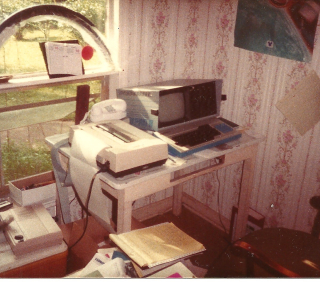
It doesn’t seem that long. It was a lifetime ago.
To the right is my original set-up. It cost $2,799. The $300 modem ran at 300 baud. That was enough in a text Internet era. I used MCI Mail to file stories with those editors advanced enough to take them that way. (MCI printed them for the rest.) I still remember a 1989 Tokyo trade show where I used my TRS100, which also had a 300 baud modem, to send copy to San Francisco, then London. Good times.
Over time modems got better. My 300 baud became a 1,200 baud when I switched to an IBM PC. Then there was a 9,600 baud unit I got for a PC compatible later in the decade. Eventually I even had one with a claimed speed of 56,000. Its maker tried to support the phone companies’ ISDN efforts and went bankrupt.

I wrote a column in 1997 in Boardwatch, begging for broadband. I got it the next year from BellSouth (now AT&T). It was DSL, a slight upgrade from ISDN. It promised speeds of nearly 1 Mbps. I don’t think I ever got them. Still, I built my own wired network in the house, Ethernet cables to each kids’ bedroom. I was in hog heaven. Bits for everyone!
Early in the 2000s Comcast began offering DOCSIS. I’d written about it for one of the industry’s trade pubs. Much faster coming down than going up, but by then most traffic was down anyway. Bandwidth was shared by the neighborhood, as Comcast used fiber sparingly, linked to coaxial cable. Service was “bundled” – cable plus Internet. It was fast, multiple megabits per second. I grabbed it.
I’d still be with Comcast except they never grounded the wire that ran from the phone pole into my house. Eventually lightning blew out my service, along with my computer. I got a new computer, then lightning hit again. Comcast still hadn’t grounded the wire.

WiFi had been around since my first broadband contract, but it couldn’t get through my house walls. Now, I found, it could. And it was even faster than my 10 Mbps Ethernet cable. My wired world became obsolete.
Fiber kept coming. Verizon and Comcast ran a second wire under my sidewalk, sharing its bandwidth as backhaul for Verizon’s cell service. Google Fiber promised a third line in the alley behind my house, but never came through. (They did clean the alley.) I changed to Google Fi for YouTube TV and cell service. My bill fell to $270/month.
Fast, wireless broadband is now an assumption of American life. This week another lightning strike knocked out my AT&T router. I had someone on the phone in minutes, and within an hour had a promise that another router would arrive in two days, one I could install myself. I went to a coffee shop for work, read my Kindle, and used my phone for news. My wife and son used their cell phones as hotspots, working as normal.
But 2023 is a different world. There’s no newspaper without the Internet. There’s no TV without WiFi. There’s no music streaming, the burglar alarm is down, and Alexa is silenced. Even my exercise bike won’t work without WiFi!
Fortunately, the new router worked. Until the next lightning strike I’m up and pedaling again.










